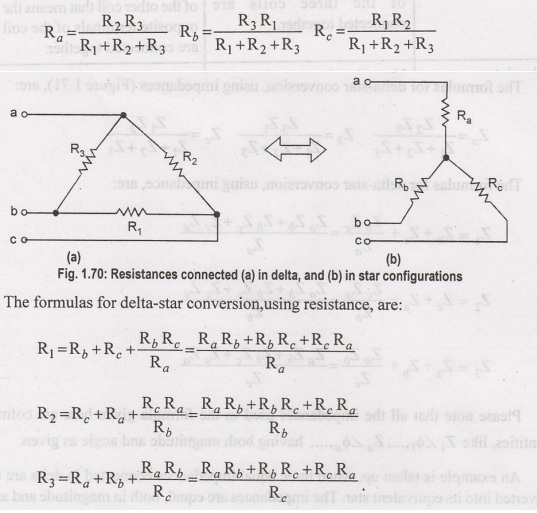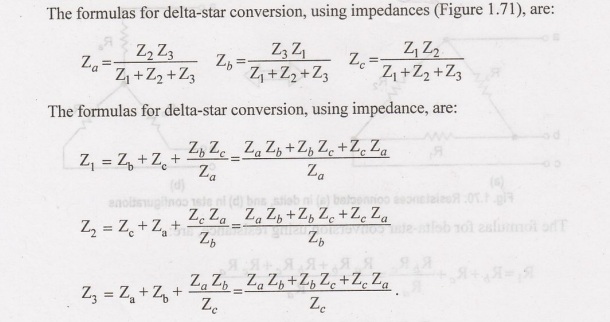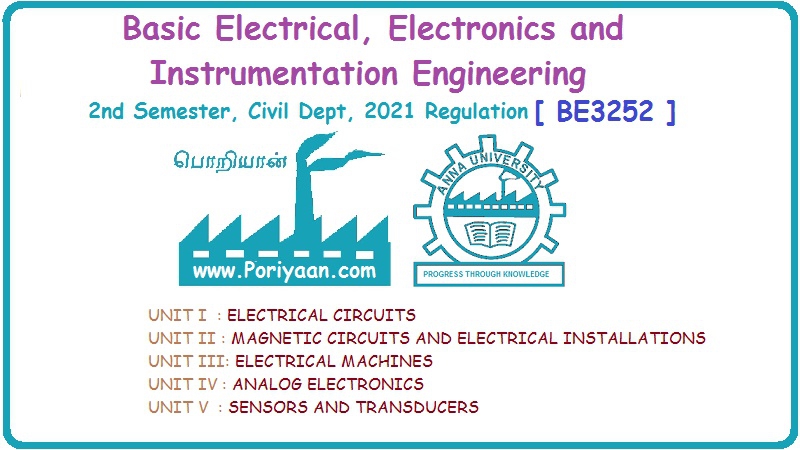Basic Electrical, Electronics And Instrumentation Engineering: UNIT I: Electrical Circuits
Delta (∆)-Star(Y) Conversion And Star-Delta Conversion
Before taking up the examples, the formula for Delta (∆)-Star(Y) conversion and also Star-Delta conversion, using impedances as needed, instead of resistance as elements.
DELTA
(∆)-STAR(Y) CONVERSION AND STAR-DELTA CONVERSION
Before
taking up the examples, the formula for Delta (∆)-Star(Y) conversion and also
Star-Delta conversion, using impedances as needed, instead of resistance as
elements. The formulas for delta-star conversion, using resistances (Figure
1.70) are:

If
three equal resistance (R1 = R2 = R3 = R)
connected in delta, are converted into its equivalent star, the resistances
obtained are equal, its value being, Ra = Rb = Rc
= (R/ 3)= R', which is derived using formulas given earlier. Similarly, if
three equal resistances connected in star, are converted into its equivalent
delta, the resultant resistances, using formulas, are equal (R1 = R2
= R3 = 3 • R' = 3 ⋅ (R/3) = R).
The
formula for the above conversions using impedances, instead of resistances, are
same, replacing resistances by impedances, as the formula for series and
parallel combination using impedances, instead of resistances, remain same as
shown in the previous module on ac single phase circuits.


Please
note that all the impedances in the formula given here are cofmplex quantities,
like Z1 201... Za Za..., having both magnitude and angle as given.
An
example is taken up, when three equal impedances connected in delta are to be
converted into its equivalent star. The impedances are equal, both in magnitude
and angle, such that |Zc|=|Z2|=|Z3|=|Z, and  The impedances connected in delta are of the form
The impedances connected in delta are of the form  . Using the
formula given here, the impedances of the star Labai doidw equivalent are also
equal, having the magnitude as:
. Using the
formula given here, the impedances of the star Labai doidw equivalent are also
equal, having the magnitude as:

The
angles of the equivalent impedance connected in star are equal to the angles of
the impedances connected in delta. The impedances connected in delta are also
equal, both in magnitude and angle, and are of the form
Similarly,
if three equal impedances connected in star are converted into its equivalent
delta, the magnitude and angle of the impedances using the formulas given here,
are  and 1=2=03=0 respectively. This shows that three impedances
are equal, both in magnitude and angle, with its value being
and 1=2=03=0 respectively. This shows that three impedances
are equal, both in magnitude and angle, with its value being

which
can also be obtained simply from the result given earlier.

Now,
let us use the above formula for the circuits (Figure 1.72), using inductances
only. The symbols used for the inductances are same (L1, ..., La...). The
impedances of the inductances connected in delta, are computed as Z11 =0.0+
jœL1 =X1 ≤90°, the angles in three cases are 90°. The magnitudes of the
impedances are proportional to the respective inductances as |Z1 = X, ∞ L1.
Converting the combination into its equivalent star, the inductances using the
formulas given here, are:

These
relations can also be derived. Further, these are of the same form, as has been
earlier obtained for resistances. It may be observed here that the formulas for
series and parallel combination using inductances, instead of resistances,
remain same, as shown in the previous module on ac single phase circuits, and
also can be derived from first principles, such as relationship of induced emf
in terms of inductance, as compared with Ohm's law for resistance. The
inductances are all ideal, i.e., lossless, having no resistive component. The
formulas for star-delta conversion using inductances (conversion of
star-connected inductances into its equivalent delta) are:

These
are of the same form as derived for circuits with resistances. If three equal
inductances (L1 =L2 =L3 =L) connected in delta, are converted into its
equivalent star, the inductances obtained are equal, its value being La=Lb Le=(L/3)=L',
which is derived using formulas given earlier. Similarly, if three equal
inductances connected in star, are converted into its equivalent delta, the
resultant inductances, using formulas, are equal (L=L2=L3=3.L'=3.(L/3)=L).

The
formulas for the circuits (Figure 1.73) using capacitances are derived here.
The symbols used for the capacitances are same (C1, ..., Ca, ...). The
impedances of the inductances connected in delta, are computed as Z1 ≤1
=0.0-jX1 = X1 ≤-90°, the angles in three cases are (- 90°). The magnitudes of
the impedances are inversely proportional to the respective capacitances as, Z1
= X = X1 = (1/∞ C) (1/C1). Converting the combination into its equivalent star,
the resultant capacitances using the formulas given here, are:

The
capacitances in this case are all ideal, without any loss, specially at power
frequency, which is true in nearly all cases, except otherwise stated. The
formulas for star- delta conversion using capacitances (conversion of
star-connected capacitances into its equivalent delta) are:

If
three equal capacitances (C1 =C2=C3=C) connected in delta, are converted into
its equivalent star, the capacitances obtained are equal, its value being Ca=Cb
=Cc =(3⋅C)=C',
which is derived using formulas given earlier. Similarly, if three equal
capacitances connected in star, are converted into its equivalent delta, the
resultant capacitances, using formula, are equal (C1 =C2=C3=C'/3=(3.C)73=C).
The
formulas for conversion of three equal inductances/capacitances connected in
delta into its equivalent star and vice versa (star-delta conversion) can also
be obtained from the formulas using impedances as shown earlier, only by
replacing inductance with with impedance, and for capacitance by replacing it
reciprocal of impedance (in both cases using magnitude of impedance only, as
the angles are equal (90° for inductance and - 90° for capacitance). Another
point to note is left for observation by the reader. Please have a close look
at the formula needed for delta-star conversion and vice versa (star-delta
conversion) for capacitances, including those with equal values of
capacitances, and then compare them with the formulas needed for such
conversion using resistances/inductances (may be impedances also). The rules
for conversion of capacitances in series/parallel into its equivalent one can
be compared to the rules for conversion of resistances/inductances in
series/parallel into its equivalent one. lios sonstoubai od 107
Exmple
The
star-connected load consists of a resistance of 15 Q, in series with a coil
having resistance of 5 Q, and inductance of 0.2 H, per phase. It is connected
in parallel with the delta-connected load having capacitance of 90 μF per phase
(Figure (a)). Both the loads being balanced, and fed from a three-phase, 400 V,
50 Hz, balanced supply, with the phase sequence as R-Y-B. Find the line
current, power factor, total power & reactive VA, and also total
volt-amperes (VA).


This
example can be solved by converting the star-connected part into its equivalent
After
starting with the generation of three-phase balanced voltage system, the phase
and line voltages, both being balanced, first for star-connection, and then or
delta-connection (both on source side), are discussed. The currents (both phase
and line) for balanced star- connected load, along with total power consumed.
Basic Electrical, Electronics And Instrumentation Engineering: UNIT I: Electrical Circuits : Tag: : - Delta (∆)-Star(Y) Conversion And Star-Delta Conversion
Related Topics
Related Subjects
Basic Electrical, Electronics and Instrumentation Engineering
BE3252 2021 Regulation | 2nd Semester Civil Dept 2021 Regulation
